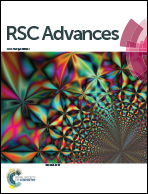Optimizing the composition of LiFSI-based electrolytes by a method combining simplex with normalization
Abstract
The optimizing method of electrolyte formulation is always vital for the development of high-performance lithium-ion batteries. Traditional optimization methods are mainly aimed at the optimization of the electrolyte composition type, and less attention is paid to the optimization of the composition proportion in a certain electrolyte formulation. In this paper, in order to balance the relationship between aluminum (Al) foil corrosion inhibition and battery electrochemical performance, the electrolyte system LiFSI0.6–LiBOB0.4–EC/DEC/EMC (1 : 1 : 1, by volume) was optimized by combining the simplex method, normalization and electrochemical testing. A lithium iron phosphate (LiFePO4) cathode with the optimized electrolyte of LiFSI0.53–LiBOB0.35–EC/DEC/EMC (1.3 : 1.5 : 1.5) delivers a high capacity (143.1 mA h g−1 at 0.5C) and remarkable cycle life (94.9% retention after 100 cycles) at 45 °C. The outstanding performance is attributed to the composition of the cathode electrolyte interphase (CEI) containing the solid and dense LiF, AlF3, B2O3 and Li2CO3. This provides a new method and idea for future electrolyte formulation optimization.



 Please wait while we load your content...
Please wait while we load your content...